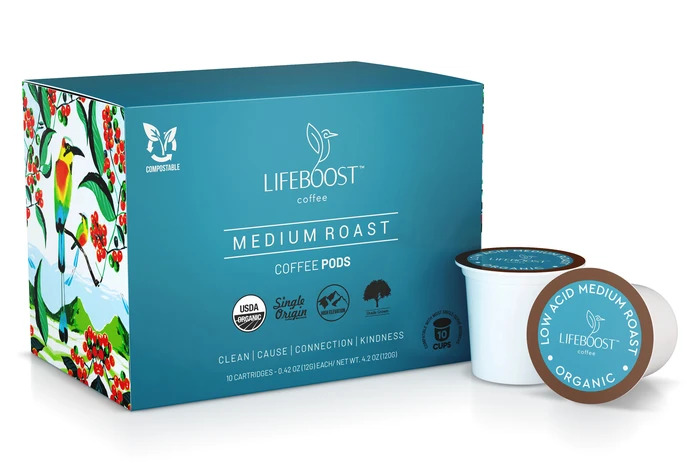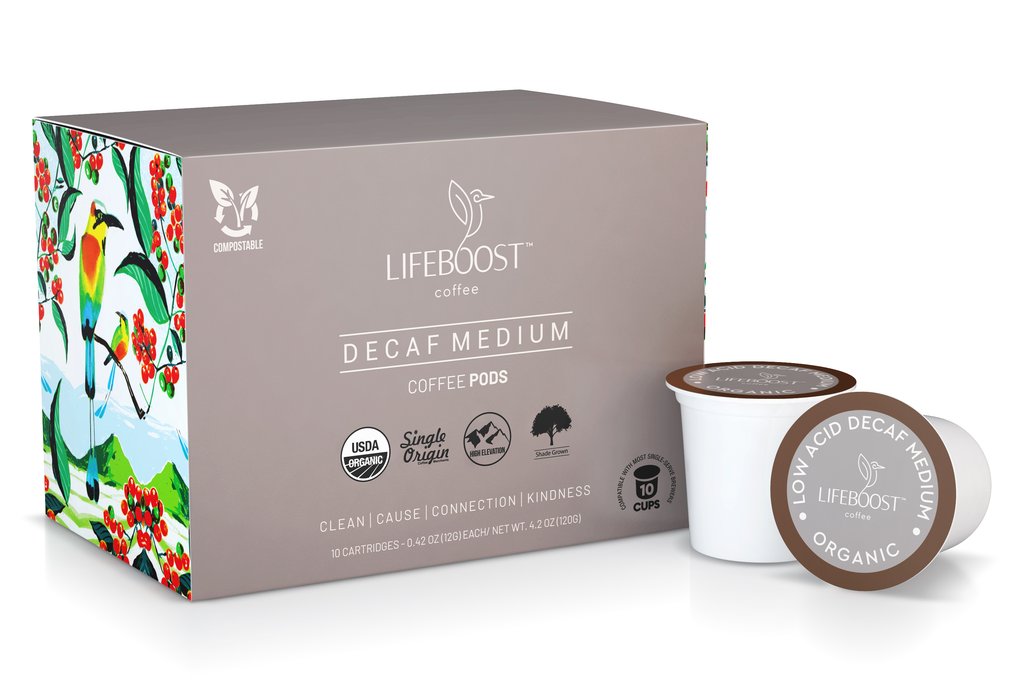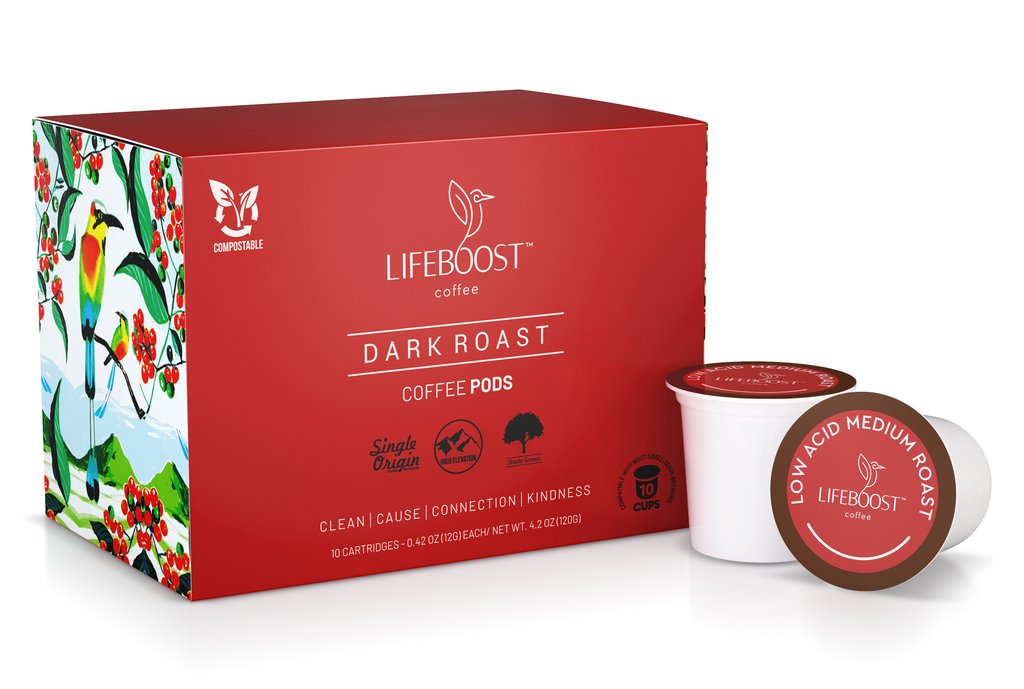13
Products Considered
149
Hours of Research
9
Experts Interviewed
26
Customers Consulted
The best low-acid coffee K-cups presented in this article will suit both people who experience stomach discomfort after drinking coffee and people who simply do not coffee's acidic taste.
Each product is organic and pH-tested.
For your convenience, we've provided a flavor profile for each coffee.
Let's take a closer look.
The Best Low Acid Coffee K-Cups Reviews
Therefore, you might find it hard to choose only the best low acid k-cups brand from the crowded market, and this is where we come into play. Urban Bean Coffee has reviewed the top 5 best low acid coffee K-cups in the world today and has given you a buyer’s guide to help you out. Here they are:
1. Lifeboost — Our Top Pick
Lifeboost's medium roast low-acid coffee is perfect for people with stomach problems. It's 27.7% less acidic than regular store coffee.
The beans are grown in the shade and then dried in the highlands of Central America.
Coffee cherries ripen slowly under the shade of trees and store more nutrients than those grown in direct sunlight.
Thanks to this, you get a coffee with a rich taste and bright aroma.
Lifeboost puts its ground specialty coffee in K-Cups. This is the highest quality Arabica, which gets a score of 80 or above on the Specialty Coffee Association (SCA) scale.
The coffee has surpassed quality standards at every stage of production. It has no defects or diseases. And every taste characteristic is appreciated by professional tasters called Q-graders.
K-Cups are compatible with Keurig and Keurig 2.0.
2. Lifeboost — Best Dark Roast
This Lifeboost dark roast coffee has a dense body and a characteristic bitter-chocolate aftertaste.
The beans are shade-grown in the highlands of Central America. They mature slowly and store nutrients.
Lifeboost coffee is suitable for people with stomach problems. It contains 27.7% less acid than regular store coffee.
The company cares about the environment. The beans are grown without the use of pesticides or chemicals, and the finished coffee is packaged in 100% compostable capsules.
K-Cups are compatible with Keurig and Keurig 2.0.
3. Puroast — Best French Roast (Darkest Roast)
Editor's Rating: 9.2

Specifications
- Type of Roast: French
- Flavor Profile: Chocolate, roasted nuts
- Certifications: Kosher, USDA Organic
- Compatible with: Keurig 2.0
Thanks to a special roasting method, this coffee contains 70% fewer acids than regular coffee.
This coffee uses a French roast—the darkest one. From these beans, you get a strong drink with a dense body and a clear bitterness. But the coffee also has pleasant flavors of dark chocolate, spices, and roasted nuts.
The coffee beans are grown on organic farms at the foot of the Andes.
The pods are compatible with Keurig 2.0 coffee makers.
4. Lifeboost — Best Decaf Pick
Lifeboost's K-Cup decaf coffee is decaffeinated using the Swiss Water Process. This is an environmentally friendly way of decaffeinating coffee while preserving its natural taste.
The method removes 99.9% of the caffeine from the beans. All it takes is water, temperature, and time.
The great thing about this decaffeinating method is that you get coffee that retains all its flavor characteristics and does not contain any chemicals.
This is important because the capsules contain ground specialty coffee. It is grown in the mountains of Central America and harvested by hand.
K-Cups will fit your Keurig and Keurig 2.0.
5. Lifeboost — Best Variety Pack
This is a great choice for those who don't want to limit themselves to one type of coffee. The variety pack includes 24 pods.
Every coffee in this pack is organic.
Your cup of low-acid coffee will be soft and delicious no matter which flavor you choose.
How to Choose the Best Low-Acid K-Cup Coffee
Coffee can be either naturally low in acid (inadvertent) or specially processed to remove acids (treated).
Inadvertent low-acid coffee occurs when coffee is grown in specific locations. If it is grown at low elevations, the beans will contain fewer acids. This is often the case with beans from Brazil, Sumatra, Peru, Guatemala, and Mexico.
You can intentionally reduce the acid level of coffee by using special roasting techniques, especially by slowly and intermittently roasting the beans.
If you want less acidic coffee, look for flavor profiles that include descriptors like chocolate, nuts, caramel, etc. These descriptors are characteristic of darker roasts, which will have lower acidity. Avoid floral or citrus flavor profiles.
Pay attention to the roast level. The darker the roast, the fewer acids there are in the beans. Light-roasted coffee has a high acidity.
If a dark roast is not for you, try medium-dark or medium.
Is Low-Acid Coffee Good For Acid Reflux?
Coffee can irritate the digestive system.
Some people report heartburn and other uncomfortable symptoms after drinking coffee.
If your cup of coffee causes discomfort, try low-acid coffee and see if that helps.
There are also ways you can reduce the acidity of the coffee you already have:
Change to a darker roast — Studies have shown that the acids in coffee affect gastric secretion. When drinking darker-roasted coffee, you'll have less secretion.
The lower acid content of dark roast coffee can be explained by the roasting process itself.
During roasting, acids come out of the beans first, then sugars, then bitter substances. The longer the beans are roasted, the less acid remains.
Brew a cold brew — The acid content of a cold brew is lower than that of hot coffee.
Choose a coarser grind — Less acid will be extracted from a coarse grind than a finer grind.
Where Do Coffee's Acids Come From?
The acids in coffee are partly responsible for its taste, but some beans contain more acids than others.
Acid levels are influenced by the following factors:
- Elevation — The higher the elevation at which coffee grows, the more acids it contains.
In high-elevation areas, there is less oxygen, more shade, and strong differences between day and night temperatures.
This affects the rate at which coffee cherries ripen. Under these conditions, they ripen more slowly and accumulate more acids and other nutrients.
- Roast — During the roasting process, beans release acids first, then sugars, then bitter substances.
To reduce the amount of acid in coffee, it can be roasted for longer. Accordingly, the darker the roast, the less acidic the coffee is.
- Brewing method — It is possible to reduce the acidity of coffee by increasing the brewing time.
Chemicals are extracted from coffee beans at different rates. Organic acids are extracted first. Then there are the components responsible for chocolate, vanilla, or caramel notes. The last compounds to be extracted are heavy substances that give the coffee an astringent, bitter taste.
Longer extraction times, such as those used for pour-over coffee, produce a sweetness that balances acidity. The longer the extraction time, the lower the ratio of acids to sweet and bitter compounds.
To extend the brewing time, you can brew your coffee in a French press or switch to a cold brew.
Summary: What Coffee Brand Offers the Best Low-Acid K-cups?
The best low-acid coffee is offered by Lifeboost. The acid content in the company's beans is 27.7% lower than in conventional beans. Lifeboost coffee is suitable for people who experience unpleasant gastrointestinal symptoms after drinking coffee.
Lifeboost uses only specialty coffee beans grown in the shade on highland plantations in Central America.







